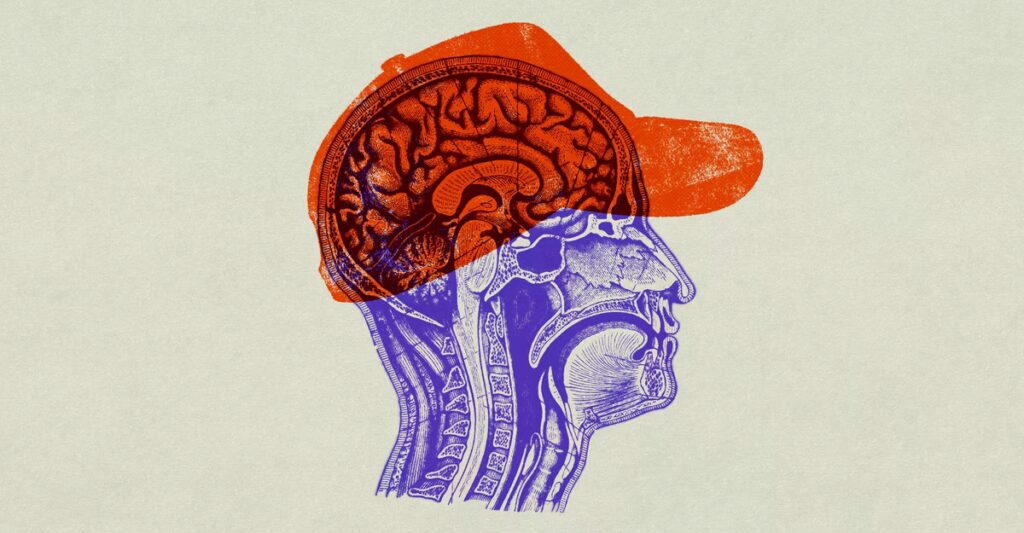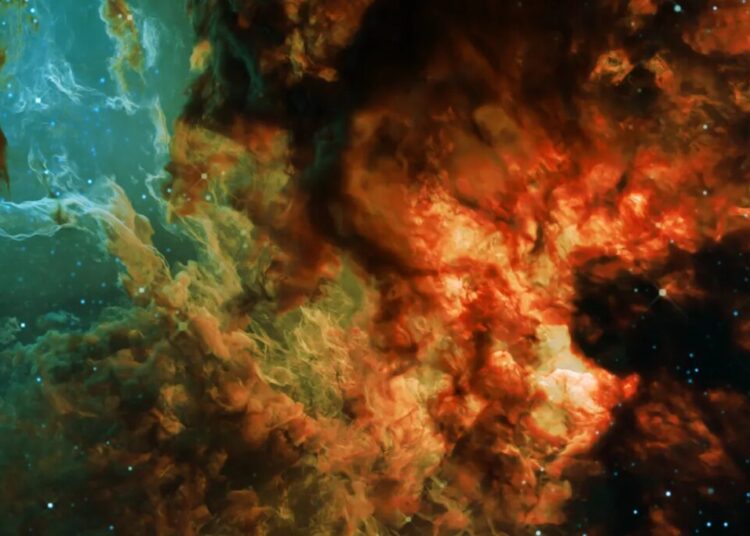“In the United States at this time,” the critic Lionel Trilling wrote in 1950, “liberalism is not only the dominant but even the sole intellectual tradition.” Conservatives and reactionaries, Trilling added, had no ideas, only impulses—“irritable mental gestures which seek to resemble ideas.” Whether the point was true in mid-century America—the reactionary writer Richard M. Weaver published Ideas Have Consequences, an attack on the modern West, two years before Trilling’s The Liberal Imagination—today it is obviously false. For the past decade or more, the intellectual energy in American politics has been on the right.
In Furious Minds: The Making of the MAGA New Right, the political theorist Laura K. Field organizes the ideas that have coalesced around Donald Trump into several schools of thought. At the Claremont Institute in California, the disciples of Leo Strauss, the intellectual guru to several generations of conservatives, combine Platonic philosophy, biblical teachings, and a reverence for the American founding into a politics of ethical and religious absolutism. Post-liberal Catholic thinkers, such as Patrick Deneen of Notre Dame and Adrian Vermeule of Harvard, believe that the liberalism of the Enlightenment has led to civilizational collapse, and only the restoration of the beloved community under Christian governance can save the West. National conservatives, including a number of Republican politicians, base their policy agenda—anti-immigrant, protectionist, isolationist, socially traditionalist—on an American identity defined by ethnic and religious heritage rather than democratic values. In Silicon Valley, techno-monarchists such as Peter Thiel and Curtis Yarvin denounce democracy itself and dream of a ruling class of entrepreneurs. And in dark corners of the internet, media celebrities and influencers with handles such as “Bronze Age Pervert” and “Raw Egg Nationalist” celebrate manliness and champion outright misogyny and bigotry.
These tendencies come with various emphases and obsessions, but the differences matter less than the common project. The MAGA ideologues who provide America’s new ruling elite with any claim to having a world view should be understood as offspring of a shared parentage, not unlike the Lovestoneites, Trotskyites, and Shachtmanites of 1930s and ’40s communism. More reactionary than conservative, their political ancestry is in the underground of the American right—Strom Thurmond, Joseph McCarthy, Patrick Buchanan—rather than the forward-looking Reaganite libertarians who dominated the Republican Party for four decades. Their favorite philosophers are not Locke and Mill but Plato, Aquinas, or even Carl Schmitt, the Nazi theorist of authoritarianism. They believe that justice and the good life can be found only in traditional sources of faith and knowledge. They share a revulsion toward liberalism and pluralism, which, they believe, have corroded the moral and spiritual fiber of America by accommodating false ideologies and harmful groups. Their modern hero is Viktor Orbán.
The American experiment in egalitarian, multiethnic democracy fills these intellectuals with anxiety, if not loathing. As Field notes, they often express undisguised hostility toward women, sexual minorities, the “woke Marxists” of the left, and the cultural elites of the “soulless managerial class.” Vermeule writes of “the common good,” and R. R. Reno, editor of the Christian journal First Things, speaks of “a restoration of love,” but the mood and rhetoric of the MAGA intellectuals are overwhelmingly negative. Without enemies they would lose vitality and focus. Their utopia is located so high in the heavens or deep in the past that the entire project always seems on the verge of collapse for lack of a solid foundation. “The movement is, in many respects, untethered from the ordinary decency and common sense that characterize America at its idealistic best,” Field writes—“and from the pluralistic reality of the country as it exists today.”
[Read: How Bronze Age Pervert charmed the far right]
The author’s background perfectly positions her to deliver this lively, devastating taxonomy and critique of MAGA’s ideologues. She was originally trained in Straussian scholarship—a reading of classical political thought that criticizes the modern turn away from the sources of moral authority toward liberalism and, in Strauss’s view, nihilism. His approach has had a deep influence on leading conservative American intellectuals of the past half century, including Allan Bloom and Harry Jaffa, the godfather of the Claremont Institute. Nearly a decade in these academic circles makes Field a knowledgeable guide to a subject she takes seriously. She’s also a Canadian woman, a double identity that puts her at a skeptical distance from the more and more extreme world of the American right.
Her exodus, as she tells it, began in 2010, when she was a fifth-year graduate student, during a lavish banquet at the University of Virginia where she was seated next to an important member of the host organization’s staff, who described meeting First Lady Michelle Obama: “Very tall, very impressive. I’d really like to fuck her.” Field excused herself to go to the restroom. Gazing in the mirror, she wondered: “What on earth am I doing here?”
She didn’t flee entirely. In the ensuing years she lingered as a sort of spy, attending conferences where speakers took turns denouncing liberalism, secularism, feminism, and modernity itself—until, in 2024, she became persona non grata. By then something had happened to the sober, pious minds of the new right. That something was Trump.
Beginning with his election in 2016, anti-liberal intellectuals made a Faustian bet that this coarse real-estate developer and reality-TV star would be the vehicle for realizing the Good, the Beautiful, and the True. “Trump was the strongman brought to bring liberalism to heel,” Field writes. But in attaching themselves to MAGA, they did less to influence the new regime than Trump did to corrupt them. Field shows, for example, how the Claremont Institute became a nest of conspiracy theorists and election denialists, with one of their own Straussians—the constitutional scholar John Eastman—providing Trump with a bogus legal justification for overturning the 2020 presidential election. Or take Deneen, a serious philosophical mind whose widely influential 2018 book, Why Liberalism Failed, was a kind of 95 theses nailed to the front door of the Enlightenment. “Whereas in 2012, in addition to disdain and skepticism, Deneen showed some sensitivity to the attractions of elite modern urban life,” Field writes, “ten years later he was naming the American elite ‘one of the worst of its kind produced in history,’ calling to ‘replace’ them, and advocating for ‘regime change.’”
Subverting the establishment is a lot more thrilling than defending it. Many of those who trade in ideas that overturn the status quo are drawn to power and have a particular weakness for extremism. Whether the likes of Steve Bannon, Michael Anton, Stephen Miller, and Tucker Carlson are driven by conviction, opportunism, personal grievance, or some combination of these motives is never easy to say. What’s clear is that MAGA ideologues—including the prize recruit to the anti-liberal right, J. D. Vance—have entered a downward spiral of ever cruder language and thought, usually with notes of bigotry and xenophobia, and sometimes blatant ugliness, as if to show their bona fides. They’ve abandoned tradition for radicalism, careful scholarship for vulgar discourse, reason for the irrational, universal truths for narrow identities, and philosophy for partisanship.
[Read: The intellectual vacuity of the national conservatives]
A few obscure figures—I wasn’t familiar with the name Julius Krein—recoiled and withdrew from the magnetic sphere around Trump. Others, such as Rod Dreher, have very recently begun to voice concern over the hateful trajectory of the American right. But reading Field, you can see something like the current wave of MAGA anti-Semitism coming from a long way off. Moral and intellectual descent is inherent in a political project that sets out to undermine liberal democracy, reject the inclusive egalitarianism of modern America, find enemies to demonize, and heroize a leader who defiles common decency. Such a movement might begin with Plato, but it will inevitably lead to Nick Fuentes.
The MAGA right has filled a vacuum created by popular disenchantment with globalization, neoliberal economics, mass immigration, political corruption, technological power, and democracy itself. A question that Field touches on but never analyzes in depth is why liberal minds haven’t produced an equally potent answer. The French cliché that the left thinks while the right governs has been nearly reversed in 21st-century America. Making the same mistake as Trilling, defenders of liberal democracy can hardly fathom any other framework for organizing modern life. “Liberals (and establishment types, too) have difficulty conceiving of perspectives and world views that differ so significantly from their own and seem so outlandish and extreme,” Field writes.
In the humanities, where the most profound questions about politics and life should be asked, many academics are so stuck in a calcified ideology of identity, with its ready-made answers, that they’ve ceased exploring fundamental moral arguments and stopped teaching the books where they can be found. In religion, progressives have a hard time admitting matters of faith as legitimate concerns in civic life. In politics, they debate policy ideas such as “the abundance agenda” and constitutional reform without confronting the deeper malaise of the modern West. To most of its adherents, liberalism means free speech, due process, rule of law, separation of powers, and evidence-based inquiry. It doesn’t join the quest for meaning and dignity that haunts our civilization.
Liberals are in the necessary but untenable position of having to defend democracy from right-wing assault in an age of broad discontent. They need their own theorists and influencers, their own institutes and manifestos, to undertake the historic task of not only reversing America’s self-destruction, but showing the next generation why liberal democracy offers the best chance for a good life.
The post The Rise and Rot of the MAGA Right appeared first on The Atlantic.




